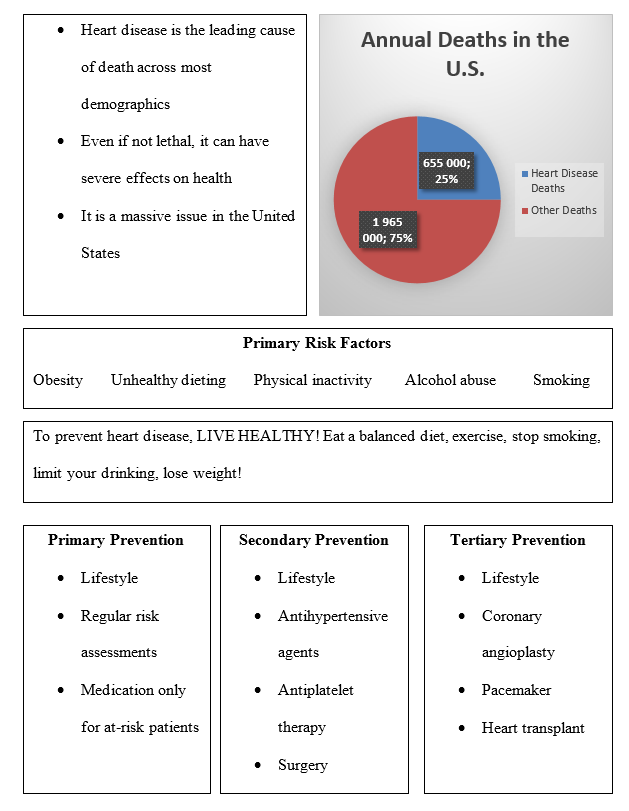
Prevention of Heart Disease in Adults
Heart disease and its consequences are prominent health issues, both in the United States and worldwide. People with cardiovascular conditions have to limit their physical activities due to fatigue, lightheadedness, pain, and other issues. Moreover, heart diseases are associated with heightened risks of strokes and similar attacks, many of which can be extremely debilitating or fatal. These risks make the disease particularly problematic since many different categories of people qualify as at elevated danger from it. However, it is also relatively simple to prevent, since in many cases, only lifestyle changes are necessary to reduce one’s chances of developing a condition significantly. As such, the situation provides an excellent opportunity to create an infographic, as the information that needs to be delivered to people is not convoluted.
The United States’ population is affected by multiple risk factors that make it a significant target for heart disease. As a result, per Heart disease facts (2020), it is currently the “leading cause of death for men, women, and people of most racial and ethnic groups in the United States,” with 1 in 4 deaths, amounting to 655,000 annually, being associated with it. The most well-known predictor for heart disease is obesity, as it is prevalent in the United States and naturally strains the heart. However, Heart disease facts (2020) also lists several other risk factors, such as diabetes, unhealthy diets, physical inactivity, and alcohol overuse. These factors are at least partially interrelated and linked to obesity but warrant a separate mention in the infographic.
The primary preventions for heart disease focus on these factors, additionally focusing on seniors, who are also at risk for heart disease. Arnett et al. (2019) recommend employing nonpharmacological interventions for the purpose, focusing on changing one’s lifestyle rather than treat the risks with medications. As such, a healthy diet and regular physical activity are excellent primary prevention options, as is a reduction in smoking or complete elimination of it. Arnett et al. (2019) also suggest 10-year atherosclerotic cardiovascular disease risk estimations for adults between 40 and 75, metformin for diabetes-2 patients if necessary, and statin therapy for patients with elevated low-density lipoprotein levels. With that said, these last interventions do not apply to most people and were not included in the infographic.
Secondary prevention for heart disease concerns people who are identified as actively at risk of developing a cardiovascular condition or suffering from a stroke. In addition to nonpharmacological measures, Wein et al. (2018) list options such as antihypertensive agents, lipid management, antiplatelet therapy, anticoagulation treatments, several other medicines, and a variety of different surgical interventions. The specific measure that is taken depends on the patient’s risk factors, such as hypertension, other conditions, or a prior stroke incident. As such, it is challenging to summarize the entirety of the measures taken for secondary prevention purposes for the purposes of inclusion in an infographic. As such, the version presented there does not go into enough details, and they are left to be listed in this description.
Unlike primary and secondary preventions, tertiary prevention takes place after a patient has developed a condition. It aims to minimize the consequences of the problem and reduce the chance of it reoccurring. Prevent heart disease (2020) recommends the same measures as for the first two varieties of prevention but places a higher emphasis on medication and surgery. In particular, operations such as coronary angioplasty, pacemaker mounting, the installation of donors’ hearts or left ventricular assist devices, and others become more feasible, depending on the severity of the heart failure. Ultimately, the decision on the option that will be taken belongs to the patient’s medical professional, and they are expected to comply. As such, a list of example measures has been featured in the infographic without a detailed explanation.
Overall, while heart disease is highly dangerous, it can also be prevented with reasonably simple measures that nearly everyone can take. In all cases, maintaining a healthy lifestyle is critical, as it can protect the person from a large portion of the risk. With that said, in severe cases, medical interventions will be necessary, and patients should be aware of this possibility. If they are adequately informed of the risks and the potential results of heart disease, they will be more likely to follow adequate measures to protect themselves. This infographic is intended for both the public and medical professionals, providing them with the necessary information on risks and treatments. It provides a compressed depiction of the problem and gives the reader a foundation to further explore and understand heart disease.
References
Arnett, D. K., Blumenthal, R. S., Albert, M. A., Buroker, A. B., Goldberger, Z. D., Hahn, E. J., Himmelfarb, C. D., Khera, A., Lloyd-Jones, D., McEvoy, J. W., Michos, E. D., Miedema, M. D., Muñoz, D., Smith Jr, S. C., Virani, S. S., Williams Sr, K. A., Yeboah, J., & Ziaeian, B. (2019). 2019 ACC/AHA guideline on the primary prevention of cardiovascular disease: Executive summary. Journal of the American College of Cardiology, 74(10), 1376-1414.
Wein, T., Lindsay, M. P., Côté, R., Foley, N., Berlingieri, J., Bhogal, S., Bourgoin, A., Buck, B. H., Cox, J., Davidson, D., Dowlatshahi, D., Douketis, J., Falconer, J., Field, T., Gioia, L., Gubitz, G., Habert, J., Jaspers, S., Lum, C., … & Gladstone, D. J. (2018). Canadian stroke best practice recommendations: Secondary prevention of stroke, practice guidelines, update 2017. International Journal of Stroke, 13(4), 420-443.
Prevent heart disease. (2020). CDC. Web.
Heart disease facts. (2020). CDC. Web.